
Robohub.org
Day one at #ScirocChallenge: social robots and humans meet in a shopping mall
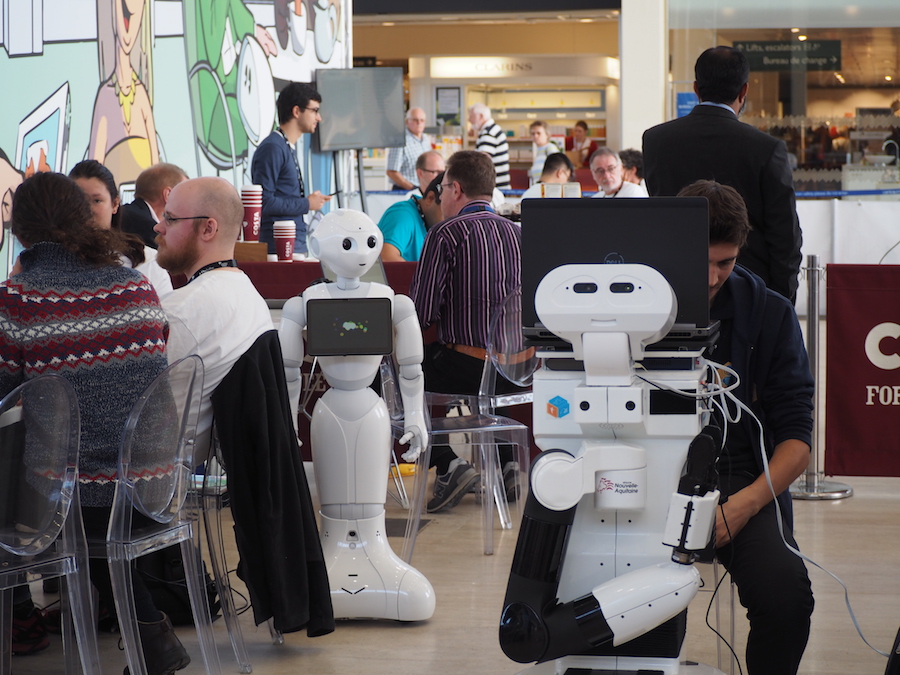
The ERL Smart Cities Robotics Challenge (SciRoc Challenge) includes five different episodes around the topic of smart shopping. Ten teams from five different countries have travelled to Milton Keynes, UK, to participate in this unique biennial event that brings together the three European Robotics League (ERL) competitions: consumer, professional and emergency.
SciRoc challenge adds the new concept of episodes to the ERL benchmarking methodology. An episode aims at targeting one or two functionalities (tested during a specific ERL Functionality Benchmark, FBM) within an operational context. For instance, delivering coffee orders or taking an elevator. In order to complete an episode, the robot might also be required to integrate other functionalities commonly used in a social environment, such as navigation or speech recognition.
Teams participate in one or more episodes during the week, and the best two will classify for the finals on Saturday.
Human-Robot interaction and Mobility
The SciRoc challenge is organised in three categories, being one of them the Human-Robot Interaction (HRI) and mobility. The episodes of this category involve robots able to show social behaviours, such as verbally interacting with (human) customers or navigating respecting proxemics, in line with the ERL Consumer Service league. Any robot, wheeled or legged, with navigational and verbal communication can participate in the two episodes available in this category: Deliver coffee shop orders (E03) and Take the elevator (E04)
Episode (E03): Deliver coffee shop orders
In this episode sponsored by COSTA Coffee the robot assists the staff of a coffee shop by taking care of the customers. The robot must recognise the status of all tables (i.e. Need serving, Already served, Needs cleaning, and Table ready), take orders, report the number of free tables, and deliver objects such as food and beverages to and from the customers’ tables.
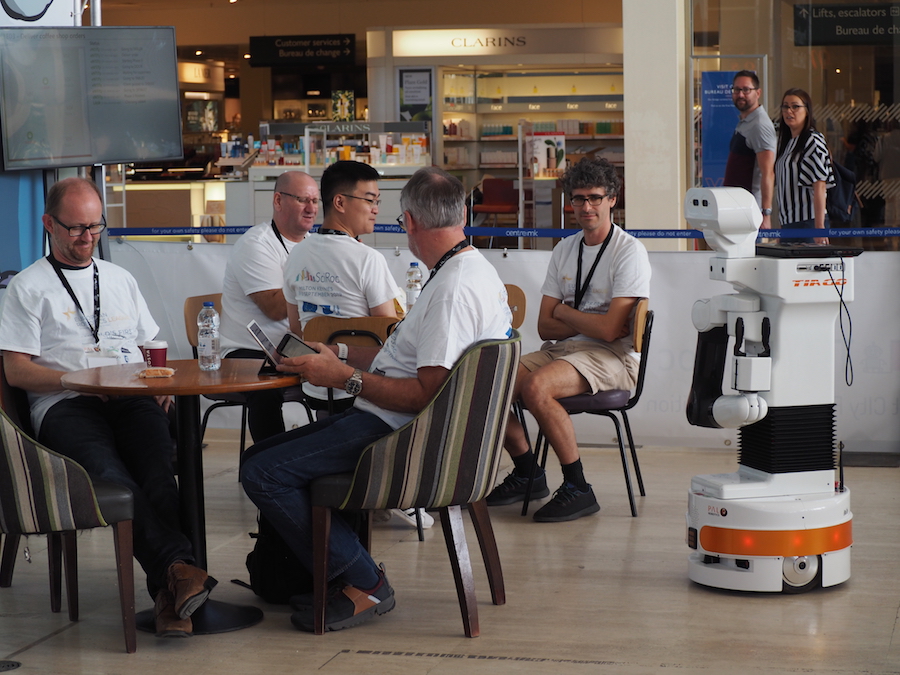
Deliver coffee shop orders set up. Photo Credits: European Robotics League
“The question I had in mind when designing the episode of Deliver coffee shop orders was: how could a robot best assist humans in a shop? We are not talking about taking their job, but to help them. For example, a catering robot can assist human servers at peak hours by handling the manual works at a fast pace and reducing the customer response time” explains Meysam Basiri, Researcher at Instituto Superior Tecnico (IST) and member of the technical committee of episode E03.
The main functionalities evaluated in this episode are people perception and object perception. However, the episode also requires other functionalities such as navigation and speech recognition.
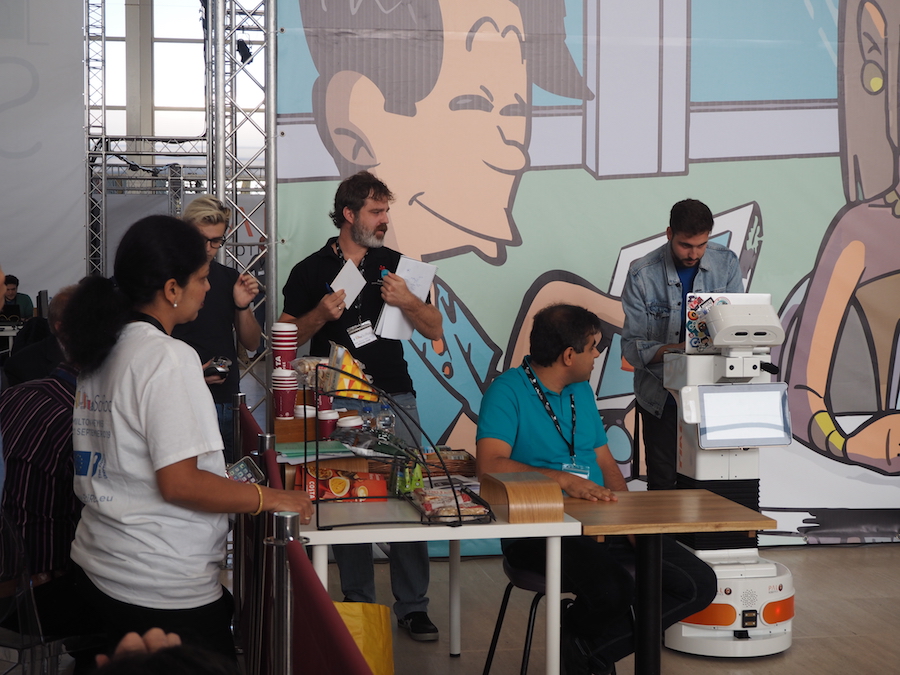
Team Gentlebots setting up the TIAGo robot for taking orders. Photo Credits: European Robotics League
The robot has 15 minutes to execute sequentially and without any interruption three phases: 1) recognising the status of all the tables and report it, 2) serving an order and 3) greeting and guiding a new customer to the table.
As HRI is not the main focus of the episode, the selection of the menu orders has been left open for the teams to decide. They can simply ask the customers to communicate the item numbers through speech, use QR codes, click the items in a display, etc.
Robots will also report their position in the shop, the table status and the orders to the smart MK data hub; this way the referees and the person at the counter will have access to the information in real-time.
The four teams competing in this episode are SocRob, Gentlebots, eNTiTy and Leeds Autonomous Service Robots. All the teams participate with the PAL Robotics TIAGo platform, except SocRob, that participates with the Monarch platform from IDmind.
Carlos Azevedo, PhD student and team member of SocRob comments, “This robot was developed to interact with children with cancer in a hospital. The group of researchers of the MONARCH project asked the kids to draw a robot and used the drawings to design the robotics platform. Therefore, it is not very tall and has that kind of cute face. People seem to empathise easily with the robot, which makes easier human-robot interaction“. He adds that the team has specifically developed for the coffee shop episode an artificial intelligence (AI) algorithm to establish conversation with the customers “we thought it would be more interesting to start a human-like conversation when the robot doesn’t, for example, understand a menu order. Sorry, did you ask for A or for B?”
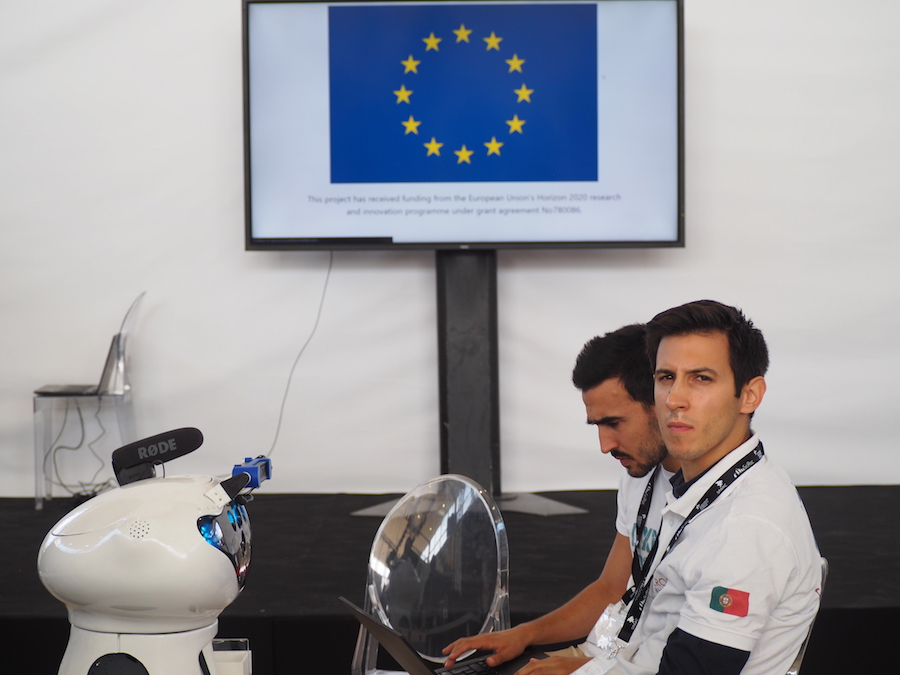
Team SocRob and their Monarch robot platform. Photo Credits: European Robotics League
Although today some of the teams experienced unexpected problems with their software, the referees are confident that their performance will improve in the next days.
Episode (E04): Take the elevator
In this HRI & mobility episode, the robot must take the elevator together with regular customers of the shopping mall to reach a service located on another floor. The robot must enter and exit the elevator at the right floor in the presence of people and interact with the MK data hub to know the floor it needs to go. Due to safety reasons and with the purpose of showing to the public how interactions inside the elevator are happening, the episode takes place in a realistic mock elevator.
The main functionality tested in this episode is navigation respecting proxemics, and it also requires other functionalities like spoken dialogue beyond command and people detection.
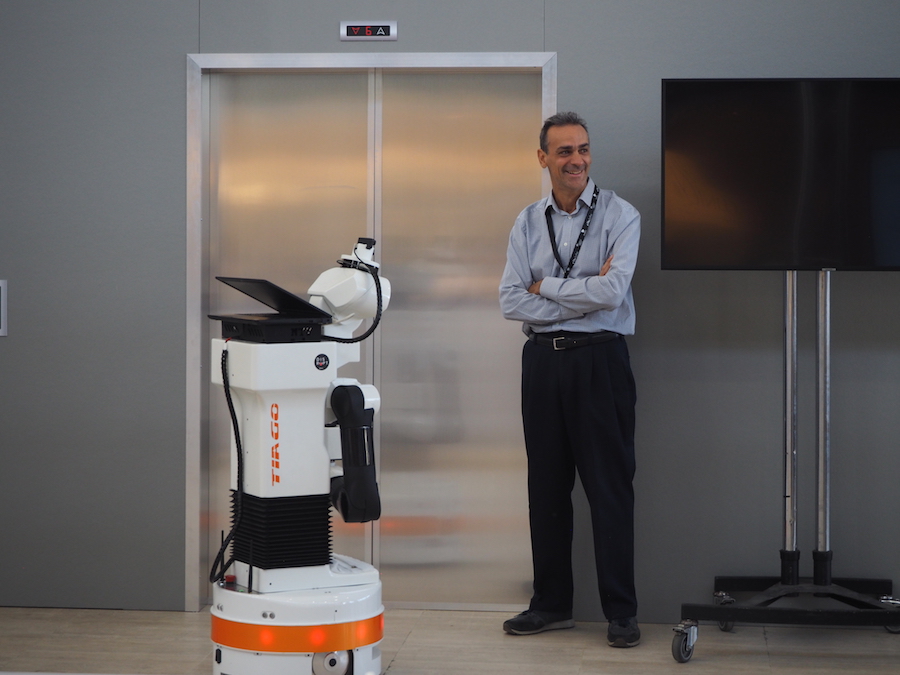
Take the elevator set up. Photo Credits: European Robotics League
Luca Iocchi, Assistant Professor at Sapienza University of Rome, and lead member of Episode E04 technical committee explains that in this episode there is a focus also on the social aspect. The robot needs to negotiate the space with humans inside the elevator, so it may need to use human social protocols. “When we take the elevator with other people, we do our best to find a comfortable space in that confined environment. That negotiation of space requires social communication. In this context, a robot needs to use these social protocols to achieve its goal. If there is missing information, ask the human. One important, and novel, element of this competition is that the customers are volunteers with no technical knowledge, and they are also involved in the evaluation of the robots”.
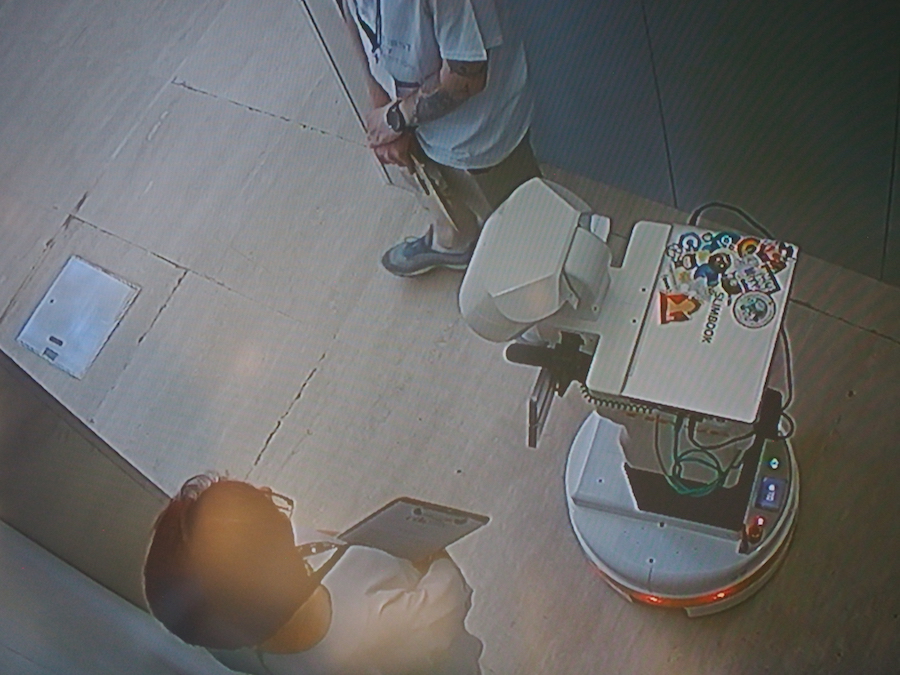
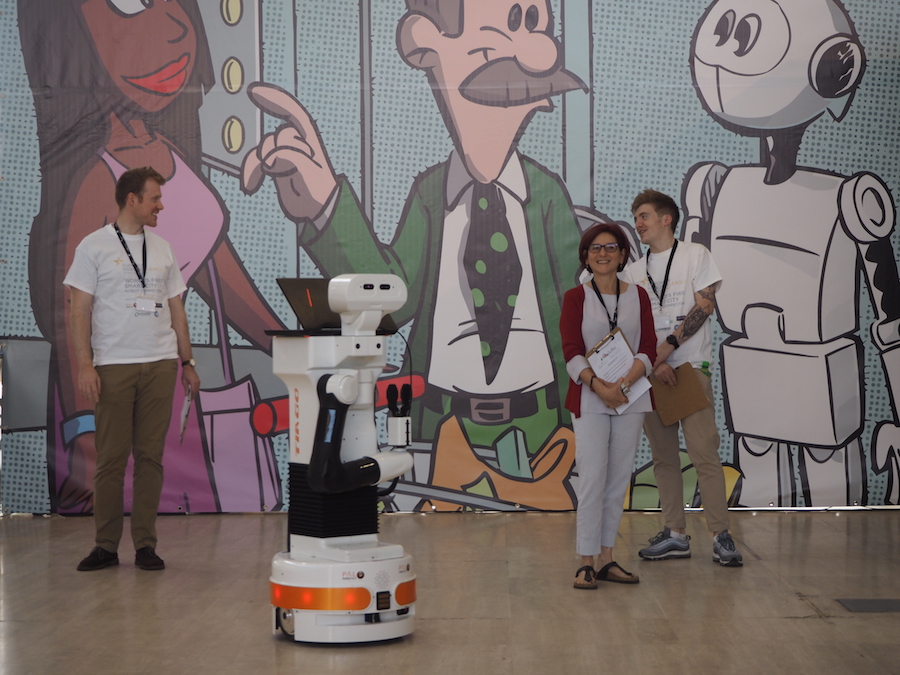 (Top) Image from the camera inside the elevator. (Bottom) Volunteers act as customers and interact with the robots. Photo Credits: European Robotics League
(Top) Image from the camera inside the elevator. (Bottom) Volunteers act as customers and interact with the robots. Photo Credits: European Robotics League
This episode has a Human-robot Interaction questionnaire as part of the performance evaluation and scoring. The questionnaire has been developed by Lu Wang, PhD student at Sapienza University of Rome, and member of the technical committee of episode E04; with the external collaboration of Mary Ellen Foster, Senior lecturer on Human-Robot Interaction at the University of Glasgow, UK. “We developed this questionnaire to evaluate users’ perceptions in a real context. We investigated previous work done in this type of questionnaires and filmed an experiment in a similar context to the one of the episode. We asked users to select from a list of behaviours which ones they saw. From their answers we designed what is now the HRI questionnaire we are using in episode E04” explains Lu Wang.
The efforts to generate this questionnaire and the episode rulebook are now part of the scientific paper “Developing a Questionnaire to Evaluate Customers’ Perception in the Smart City Robotic Challenge” that will be presented at the 28th Edition of the IEEE International Conference on Robot and Human Interactive Communication (Ro-Man 2019).
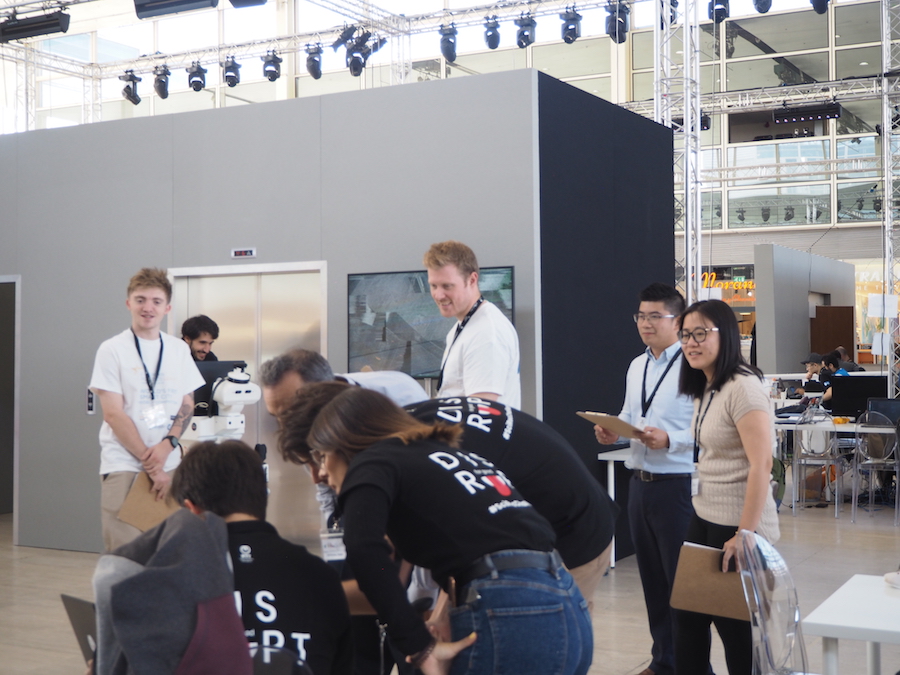
Teams members, referees and volunteers. Photo Credits: European Robotics League
The award for the best social robot has unleashed teams’ creativity when developing the human-robot interaction. Referees have already seen volunteers laughing at some of the robots’ comments.
“Humans are helpful by nature. They want to take part in activities when they see a robot that reminds them of the future. If the robot is more human-like and behaves more like a human, it will be better accepted by customers. In that context we can also predict some actions or behaviours of the customers. We use the Pepper robot because it has a soft voice and a broad range of gestures, therefore is less likely to scare people. If a robot relies on being expressive, it can rely on people to help it.” says Daniel Delgado Bellamy, research associate at the Bristol Robotics Laboratory and team member of HEARTS.
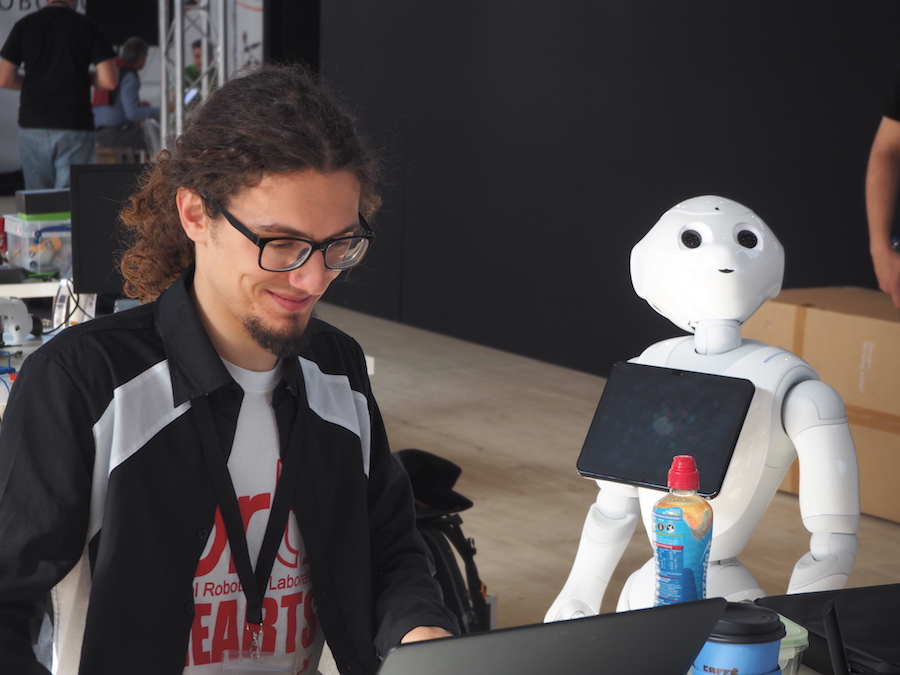
Daniel and Pepper robot. Photo Credits: European Robotics League
In this first day, the five participating teams (HEARTS, Gentlebots, Leeds Autonomous Service Robots, eNTiTy and Robotics Lab UC3) performed without major problems.
Team Gentlebots completed the episode in the first day with a TIAGO robot they loaned from SciRoc platinum sponsor PAL robotics. “We have been working with TIAGo since June this year. Our research team focuses in cognitive architecture oriented to social robots. We chose the platform without the manipulator, because we were only interested in the social navigation and dialogue. TIAGo is definitely an easy and powerful platform to work with” says Francisco Martin Rico, Associate Professor at Universidad Rey Juan Carlos, and Team leader of Gentlebots.
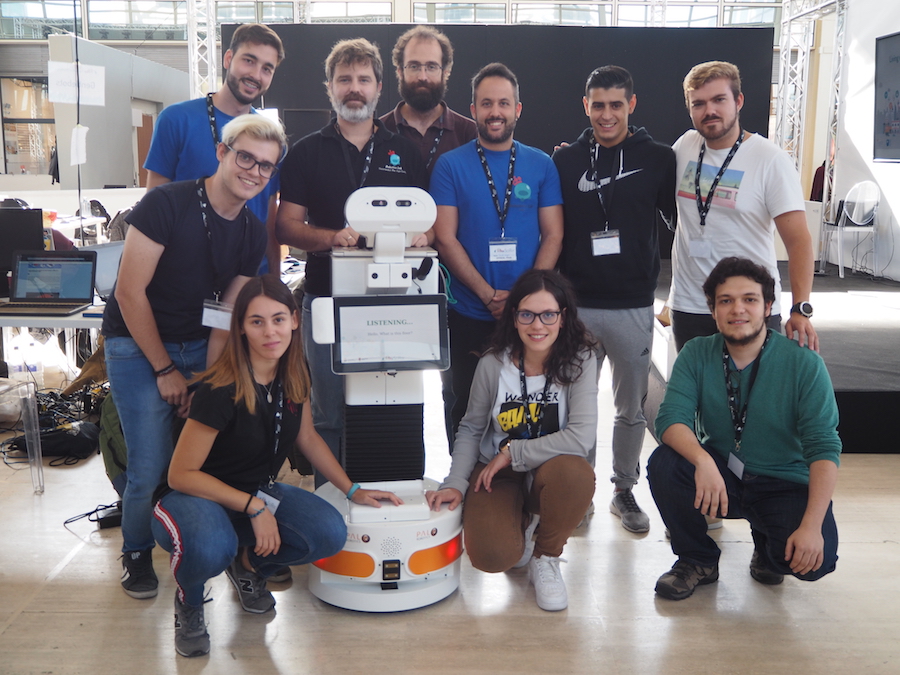
Team Gentlebots from the Rey Juan Carlos University and the University of León, Spain. Photo Credits: European Robotics League
For a detailed description of the episodes and the evaluation criteria, check the SciRoc Rulebook – episode E03 and SciRoc Rulebook – Episode E04.
Watch this space for Day Two: robot manipulation in human environments!




